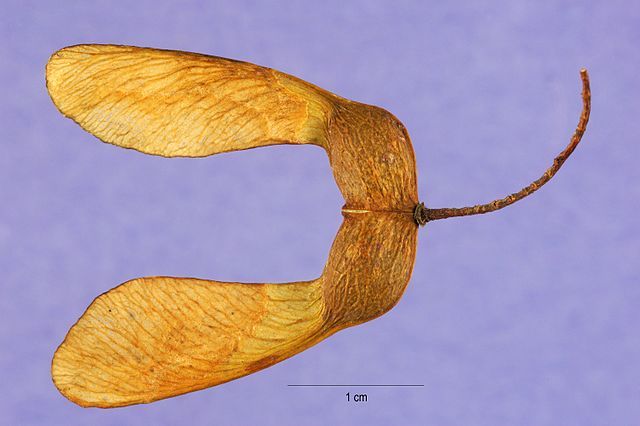Sugar Maple : Life History
As with many plants, the life of a sugar maple begins as a seed. The specific seed structure of maples in general is known as a samara. These basically consist of a swollen fruit at one end that is attached to a thin membrane, which acts as an airfoil, allowing the seed to travel significant distances on air currents. These samaras grow in pairs on the tree and look a great deal like a horseshoe, with a total length of between 1ʺ and 1.75ʺ. Being angiosperms, these are actually true dry fruits that develop from the ovaries of pollinated flowers. Interestingly, the sugar maple produces both perfect flowers, which contain male and female reproductive structures, as well as imperfect flowers that contain only one type of structure. After pollination in the spring, typically performed by bees, the seeds develop throughout the summer months, maturing by early autumn. The samaras are dropped by the tree in the fall and overwinter under the snowpack, germinating in the spring. The optimum temperature for sugar maple seed germination, following the winter stratification period, has been found to be 34° F, the lowest known temperature for any forest tree.
Once the seed germinates, it will of course immediately begin to grow. However, since sugar maples are typically found in established forests, their seedlings are uniquely well adapted to developing in partial to nearly full shade and seem to be perfectly content to wait, sometimes for many years, until space and light become available. The saplings will grow about one foot in height and around two tenths of an inch in diameter per year, on average, until about age 40. This is also approximately the age at which the tree begins to produce seeds of its own. Over the next several decades, the growth rate will begin to slow as the tree matures. Growth of all varieties comes to a near complete halt after around 150 years, but the tree can continue to survive and thrive for two to three times that long. At maturity, most sugar maples reach heights of 70 to 90 feet and have trunk diameters of upwards of three feet. The form of the tree is dependent on where it grew, with forest trees growing tall and straight, with no branches appearing until nearly the top of the tree, and field trees developing a more open form. These field trees also tend to begin branching from one central area low on the trunk, forming a distinctive silhouette.

